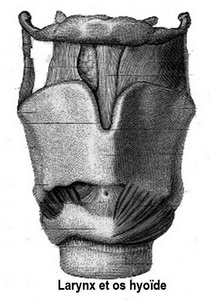Coulombe Michèle - L’os hyoïde, un maillon clé dans l’amorce du processus de normalisation posturale
Maîtres de mémoire :
- Voyer Guy, D.O.
Mémoire pour l’obtention du Diplôme d’Ostéopathie présenté et soutenu publiquement le 26 septembre 2007 à Montréal - Académie Sutherland d’Ostéopathie - Québec - Directeur du mémoire : Guy Voyer DO

RÉSUMÉ

L’os hyoïde est un acteur déterminant dans le maintient de l’homéostasie. Il est situé à un carrefour ou de grandes fonctions vitales sont réalisées, comme la déglutition, la mastication, la phonation et la respiration. Pour l’ostéopathe, il est en lien avec trois diaphragmes ; crânien, cervico-thoracique et thoracique.
Tel un niveau à bulle, il est le reflet de tension se répercutant à tout l’organisme par le biais des trois principales chaînes du corps soit la chaîne ventriculo-épicrânienne, la chaîne médiastinale et la chaîne hyoïdienne, puisqu’il est suspendu par des haubans myofasciaux, fasciaux et aponévrotiques au système crânio-sacré, à l’orifice supérieur du thorax, aux membres supérieurs, à la base de la langue, à l’épiglotte et au larynx.
L’os hyoïde interagit aussi avec d’autres systèmes, comme le système postural, qui lui est sous la dépendance d’informations fournies par des endocapteurs et des exocapteurs. Ces capteurs réagissent aux moindres fluctuations et occasionnent des modifications du tonus postural via le système myo-fascial. C’est au travers des informations myo-fasciales transmises par l’os hyoïde que la cohérence des réactions posturales engendre des réactions régulées par le système nerveux central. Le test de Fukuda nous permet d’objectiver cette réponse posturale avant et après avoir normaliser l’os hyoïde par les techniques de la chaîne hyoïdienne. Pour normaliser le système postural, il convient de normaliser les différents outils, soit le système oculaire, le système manducateur, les récepteurs de la colonne par rapport au sacrum et aux axes du bassin, le système podal de même que l’os hyoïde.

ABSTRACT
The hyoid bone is an actor determining in maintains homeostasis. It is located at a crossroads or great vital functions are fulfilled, like swallowing, the chewing, phonation and breathing. For the osteopath, it is in bond with three diaphragms ; cranial, cervico-thoracic and thoracic.
A such spirit level, it is the reflection of tension being reflected at all the organization by the means of the three principal chains of the body is the ventriculo-epicranial chain, the mediastinal chain and hyoid chains it, since it is suspended by stays myofascial, fascial and aponevrotic with the craniocrowned system, the higher opening of the thorax, the upper limbs, the base of the language, the épiglottis and the larynx.
The hyoid bone also interacts with other systems, like the postural system, which is to him under the dependence of information provided by endocaptor and exocaptor. These sensors react to the least fluctuations and cause modifications of postural tonicity via the system myo-fascial. It is through the information myo-fasciales transmitted by the hyoid bone that the coherence of the postural reactions generates reactions controlled by the central nervous system. The test of Fukuda enables us to objectify this postural answer before and after having to standardize the hyoid bone by the techniques of the hyoid chain. To standardize the postural system, it is advisable to standardize the various tools, that is to say the ocular system, the system manducator, the receivers of the column compared to the sacrum and the axes of the basin, the system podal just as the hyoid bone.
SOMMAIRE
1. INTRODUCTION GÉNÉRALE
1.1 Le concept de complexité
1.2 Problématique
1.3 Hypothèse
2. L’OS HYOÏDE EN OSTÉOPATHIE
3. EMBRYOLOGIE
3.1 Le 2ème arc pharyngien (arc hyoïdien)
3.2 Le 3ème arc pharyngien
4. ANATOMIE
4.1 Rappels anatomiques
4.1.1 Les muscles
4.1.1.1 La région sus-hyoïdienne
4.1.1.2 La région sous-hyoïdienne
4.1.2 Tissus fasciaux
4.1.2.1 Ligaments
4.1.2.2 Fasciae proprement dit
4.1.2.3 Aponévroses
4.2 Anatomie relationnelle
4.3 Biomécanique
4.3.1 La mastication et la déglutition
4.3.2 La succion
4.3.3 La phonation
4.3.4 La respiration
5. LA POSTURE
5.1 Physiologie
5.1.1 Les informations sensorielles
5.1.1.1 Les exocapteurs
5.1.1.2 Les endocapteurs
5.1.2 Les voies de transmission
5.1.3 Les centres d’intégration et de contrôle
5.2 L’os hyoïde : un niveau à bulle
6. LA CHAÎNE HYOÏDIENNE
7 MÉTHODOLOGIE EXPÉRIMENTALE
7.1 Protocole thérapeutique
7.2 Justification du choix des maillons de la chaîne hyoïdienne
7.3 Outils de validation
7.3.1 Test de Fukuda
7.3.2 Palpation
7.4 Groupe d’exclusion
8 RÉSULTATS
9. ANALYSE
10 CONCLUSION
11 ANNEXES
12 BIBLIOGRAPHIE



